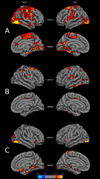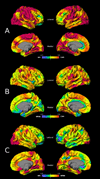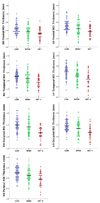Cortical thickness in neuropsychologically near-normal schizophrenia
- PMID: 21981933
- PMCID: PMC3225719
- DOI: 10.1016/j.schres.2011.08.017
Cortical thickness in neuropsychologically near-normal schizophrenia
Abstract
Schizophrenia is a severe psychiatric illness with widespread impairments of cognitive functioning; however, a certain percentage of subjects are known to perform in the normal range on neuropsychological measures. While the cognitive profiles of these individuals have been examined, there has been relatively little attention to the neuroanatomical characteristics of this important subgroup. The aims of this study were to statistically identify schizophrenia subjects with relatively normal cognition, examine their neuroanatomical characteristics relative to their more impaired counterparts using cortical thickness mapping, and to investigate relationships between these characteristics and demographic variables to better understand the nature of cognitive heterogeneity in schizophrenia. Clinical, neuropsychological, and MRI data were collected from schizophrenia (n = 79) and healthy subjects (n = 65). A series of clustering algorithms on neuropsychological scores was examined, and a 2-cluster solution that separated subjects into neuropsychologically near-normal (NPNN) and neuropsychologically impaired (NPI) groups was determined most appropriate. Surface-based cortical thickness mapping was utilized to examine differences in thinning among schizophrenia subtypes compared with the healthy participants. A widespread cortical thinning pattern characteristic of schizophrenia emerged in the NPI group, while NPNN subjects demonstrated very limited thinning relative to healthy comparison subjects. Analysis of illness duration indicated minimal effects on subtype classification and cortical thickness results. Findings suggest a strong link between cognitive impairment and cortical thinning in schizophrenia, where subjects with near-normal cognitive abilities also demonstrate near-normal cortical thickness patterns. While generally supportive of distinct etiological processes for cognitive subtypes, results provide direction for further examination of additional neuroanatomical differences.
Copyright © 2011 Elsevier B.V. All rights reserved.
Figures






References
-
- Albus M, Hubmann W, Scherer J, Dreikorn B, Hecht S, Sobizack N, et al. A prospective 2-year follow-up study of neurocognitive functioning in patients with first-episode schizophrenia. Eur Arch Psychiatry Clin Neurosci. 2002;252(6):262–267. - PubMed
-
- Allen DN, Huegel SG, Seaton BE, Goldstein G, Gurklis JA, van Kammen DP. Confirmatory factor analysis of the WAIS-R in patients with schizophrenia. Schizophr Res. 1998;34(1–2):87–94. - PubMed
-
- Allen DN, Seaton BE, Goldstein G, Sanders RD, Gurklis JA, Jr., Peters JL, et al. Neuroanatomic differences among cognitive and symptom subtypes of schizophrenia. J Nerv Ment Dis. 2000;188(6):381–384. - PubMed
Publication types
MeSH terms
Grants and funding
LinkOut - more resources
Full Text Sources
Medical

